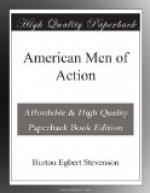The British squadron consisted of six vessels, mounting 63 guns, and manned by 502 men. The American ships mounted 54 guns, with 490 men. Although of smaller total weight than the American guns, the British guns were longer and would carry farther, and so were much more effective. The British crews, too, were better disciplined, a large number of the men being from the royal navy, and the squadron was commanded by Robert Heriot, a man of much experience, who had fought under Nelson at Trafalgar.
The American shore was lined with an anxious crowd, who appreciated the great issues which hung upon the battle. Perry, calling his men aft, produced a blue banner bearing in white letters the last words of the man after whom the Lawrence was named: “Don’t give up the ship!”
“Shall I hoist it, boys?” he asked.
“Aye, aye, sir!” they shouted, and the bunting was run up to the main-royal masthead. Then a hush fell upon the water as the two fleets drew together. A few minutes before noon the engagement began, Perry heading straight for the flagship of the enemy, and drawing the fire of practically the whole British squadron by running ahead of the other ships, which, owing to the light breeze, could not get within range. For two hours, he fought against these hopeless odds, and almost without support, until his ship was reduced to a wreck and only one of her guns could be worked, while of her crew of 103, only twenty were left on their feet. Every nook and corner of the brig was occupied by some wounded and dying wretch seeking vainly to find shelter from the British fire. Even the cockpit, where the wounded were carried for treatment, was not safe, for some of the men were killed while under the surgeon’s hands. No fewer than six cannon balls passed through the cockpit, while two went through the magazine, which, by some miracle, did not explode. The ship was so disabled, at last, that it drifted out of action, and Perry, taking his pennant and the blue flag bearing the words “Don’t give up the ship!” under his arm, got into a boat with four seamen, and started for the Niagara, his other brig.
The British saw the little boat dancing over the waves, and after a moment of dazed astonishment at a manoeuvre unheard of in naval warfare and daring almost to madness, concentrated their fire on it. One cannon ball penetrated the boat, but Perry, stripping off his coat, stuffed it into the hole and so kept the boat afloat until the Niagara was reached. Clambering on board, Perry ran up his flags, reformed his line, closed with the enemy, raked them, engaged them at close quarters, where their long guns gave them no advantage, and conducted an onslaught so terrific that, twenty minutes later, the entire British squadron had hauled down their flags.




